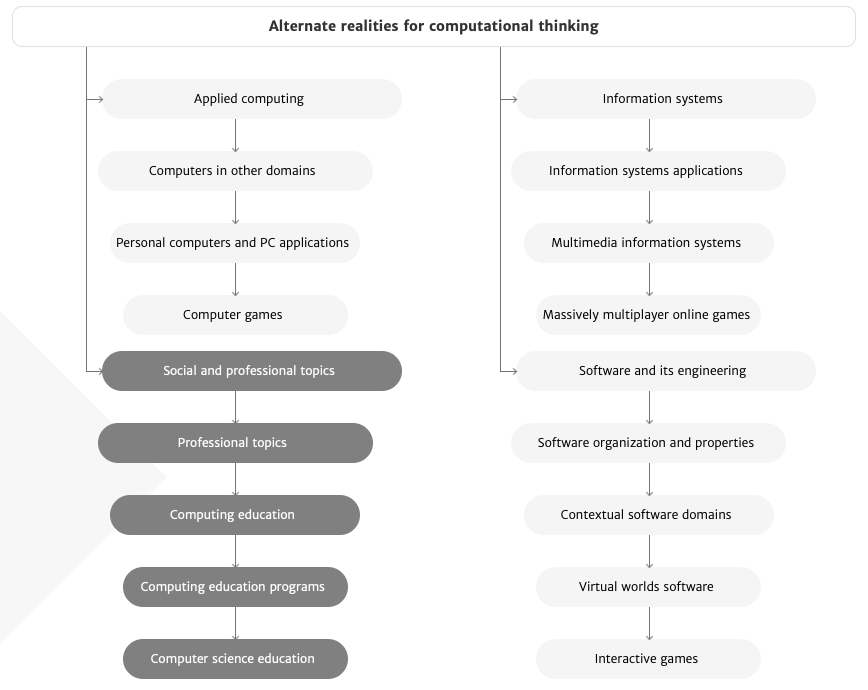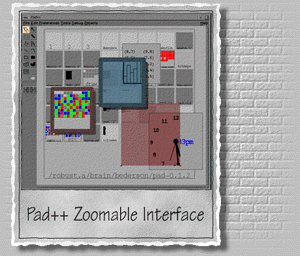Secondary Research
Doore, Karen. “Alternate Realities for Computational Thinking.” Proceedings of the ninth annual international ACM conference on International computing education research - ICER ‘13, August 1, 2013. https://doi.org/10.1145/2493394.2493418.
Alternate Reality Games (ARGs) can be utilized as an educational platform to engage students in a collaborative exploration of the field of computing as a means to increase interest in computing.

Anand, Abhinav, Veljko Pejovic, Elizabeth M. Belding, and David L. Johnson. “VillageCell.” Proceedings of the Fifth International Conference on Information and Communication Technologies and Development - ICTD ‘12, March 2012. https://doi.org/10.1145/2160673.2160698.
VillageCell relies on software defined radios and open-source solutions to provide free local and cheap long-distance communication for remote regions.
Matthee, K. W., G. Mweemba, A. V. Pais, G. van Stam, and M. Rijken. “Bringing Internet Connectivity to Rural Zambia Using a Collaborative Approach.” 2007 International Conference on Information and Communication Technologies and Development, 2007. https://doi.org/10.1109/ictd.2007.4937391.
The service operates using satellite terminals (for connection to the Internet) and a wireless local area network. The provision of Internet access has enabled local health institutes to operate more effectively and given local people the opportunity to communicate and explore new ideas.
Warschauer, Mark. Technology and Social Inclusion: Rethinking the Digital Divide. Cambridge, MA: MIT, 2004.
Interesting read-nice direction to head in, if obvious
Bederson, Benjamin B., James D. Hollan, Ken Perlin, Jonathan Meyer, David Bacon, and George Furnas. “Pad++: A Zoomable Graphical Sketchpad For Exploring Alternate Interface Physics.” Journal of Visual Languages & Computing 7, no. 1 (1996): 3–32. https://doi.org/10.1006/jvlc.1996.0002.
envision a rich world of dynamic persistent informational entities that operate according to multiple physics specifically designed to provide cognitively facile access and serve as the basis for the design of new computationally-based work materials.

Raman, Aravindh, Sagar Joglekar, Emiliano De Cristofaro, Nishanth Sastry, and Gareth Tyson. “Challenges in the Decentralised Web.” Proceedings of the Internet Measurement Conference, 2019. https://doi.org/10.1145/3355369.3355572.
enabling the operation of web infrastructure and services without centralised ownership or control.
Conor Linehan, Ben J. Kirman, Stuart Reeves, Mark A. Blythe, Theresa Jean Tanenbaum, Audrey Desjardins, and Ron Wakkary. “Alternate endings: using fiction to explore design futures.” CHI ‘14 Extended Abstracts on Human Factors in Computing Systems. Association for Computing Machinery, 2014. https://doi.org/10.1145/2559206.2560472
fictional narratives to envision long-term consequences of contemporary HCI projects
Sanchez-Iborra, Ramon, and Antonio F. Skarmeta. “TinyML-Enabled Frugal Smart Objects: Challenges and Opportunities.” IEEE Circuits and Systems Magazine 20, no. 3 (August 13, 2020): 4–18. https://doi.org/10.1109/mcas.2020.3005467.
The TinyML paradigm proposes to integrate Machine Learning (ML)-based mechanisms within small objects powered by Microcontroller Units (MCUs). This paves the way for the development of novel applications and services that do not need the omnipresent processing support from the cloud, which is power consuming and involves data security and privacy risks.
David, Robert, Jared Duke, Advait Jain, Vijay Janapa Reddi, Nat Jeffries, Jian Li, Nick Kreeger, et al. “TensorFlow Lite Micro: Embedded Machine Learning on TinyML Systems.” arXiv.org. Cornell University, October 20, 2020. https://arxiv.org/abs/2010.08678.
Looks at the finer technicalities of running ML models on smaller edge systems
Banbury, Colby R., C. Zhou, I. Fedorov, R. Navarro, Urmish Thakker, Dibakar Gope, V. Reddi, Matthew Mattina, and P. N. Whatmough. “[PDF] MicroNets: Neural Network Architectures for Deploying TinyML Applications on Commodity Microcontrollers: Semantic Scholar.” undefined. Semantic Scholar, 2020. https://www.semanticscholar.org/paper/MicroNets%3A-Neural-Network-Architectures-for-TinyML-Banbury-Zhou/fd9e3e0b047a6d2b13b7a301e552bc375c8ebe09.
Executing machine learning workloads locally on resource constrained microcontrollers (MCUs) promises to drastically expand the application space of IoT. However, so-called TinyML presents severe technical challenges, as deep neural network inference demands a large compute and memory budget. To address this challenge, neural architecture search (NAS) promises to help design accurate ML models that meet the tight MCU memory, latency and energy constraints.
Lin, J., Wei-Ming Chen, Yujun Lin, J. Cohn, Chuang Gan, and Song Han. “[PDF] MCUNet: Tiny Deep Learning on IoT Devices: Semantic Scholar.” undefined. Semantic Scholar, 2020. https://www.semanticscholar.org/paper/MCUNet%3A-Tiny-Deep-Learning-on-IoT-Devices-Lin-Chen/ea142242898ccc797af88cc633fb8618b272ee62.
Combine multiple devices to create a local net: MCUNet, a framework that jointly designs the efficient neural architecture (TinyNAS) and the lightweight inference engine (TinyEngine), enabling ImageNet-scale inference on microcontrollers.
Liu, Di, Hao Kong, X. Luo, Weichen Liu, and R. Subramaniam. “[PDF] Bringing AI To Edge: From Deep Learning’s Perspective: Semantic Scholar.” undefined. Semantic Scholar, 2020. https://www.semanticscholar.org/paper/Bringing-AI-To-Edge%3A-From-Deep-Learning’s-Liu-Kong/75f9918fe00a5bf83092b989e2ed3b9ca0f10a4e.
Overview of the Edge world and future development roadmaps
Vuppalapati, Chandrasekar, Anitha Ilapakurti, Sharat Kedari, Jaya Vuppalapati, Santosh Kedari, and Raja Vuppalapati. “Democratization of AI, Albeit Constrained IoT Devices & Tiny ML, for Creating a Sustainable Food Future.” 2020 3rd International Conference on Information and Computer Technologies (ICICT), March 9, 2020. https://doi.org/10.1109/icict50521.2020.00089.
develop a framework to deploy artificial intelligence models in constrained compute environments that enable remote rural areas and small farmers to join the data revolution and start contribution to the digital economy and empowers the world through the data to create a sustainable food for our collective future. This is the direction I need to head in. Tiny computers-context-local control-huge win
Chen, Jiasi, and Xukan Ran. “[PDF] Deep Learning With Edge Computing: A Review: Semantic Scholar.” Semantic Scholar, 2019. https://www.semanticscholar.org/paper/Deep-Learning-With-Edge-Computing%3A-A-Review-Chen-Ran/4f2d4e821dd03ac5df7d5448948bc738aefdd6db.
Overview of edge sensors and compute modules
Zhou, Z., X. Chen, E. Li, Liekang Zeng, K. Luo and Junshan Zhang. “Edge Intelligence: Paving the Last Mile of Artificial Intelligence With Edge Computing.” Proceedings of the IEEE 107 (2019): 1738-1762. https://www.semanticscholar.org/paper/Edge-Intelligence%3A-Paving-the-Last-Mile-of-With-Zhou-Chen/928cd808aba140ec298508df87c5579811ff2f41
a comprehensive survey of the recent research efforts on Edge Intelligence
Han, Yiwen, X. Wang, Victor C. M. Leung, D. Niyato, Xueqiang Yan and X. Chen. “Convergence of Edge Computing and Deep Learning: A Comprehensive Survey.” IEEE Communications Surveys & Tutorials 22 (2020): 869-904. https://www.semanticscholar.org/paper/Convergence-of-Edge-Computing-and-Deep-Learning%3A-A-Han-Wang/4cd03cd34e7e94d1b1ee293d5dead8efc24c1a6d
Survey of Edge Intelligence and Edge computing